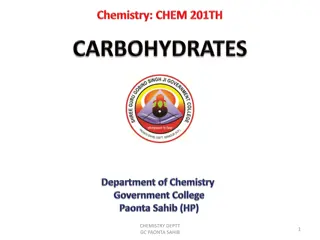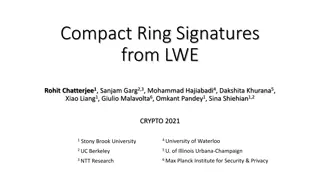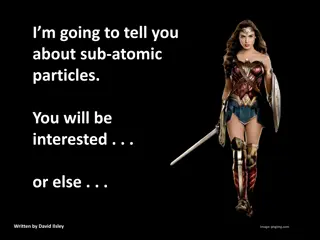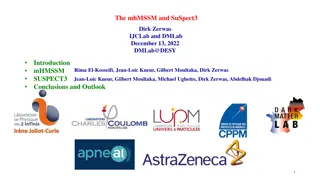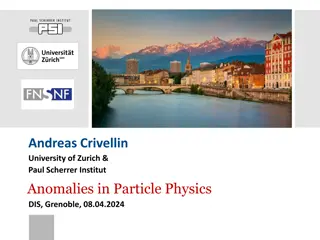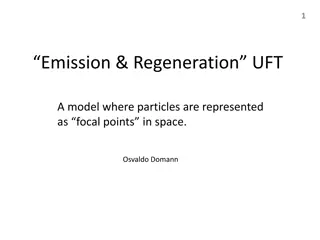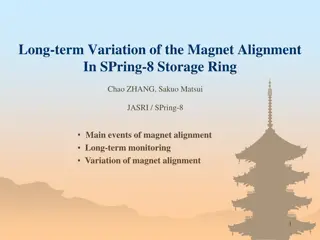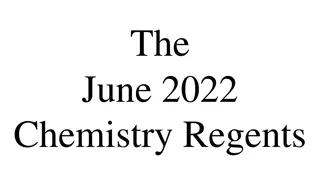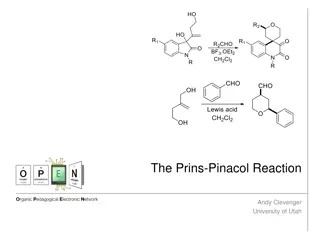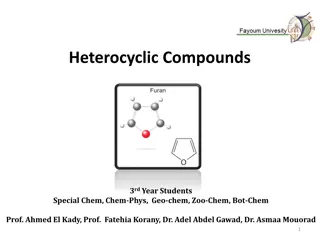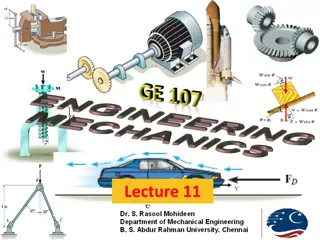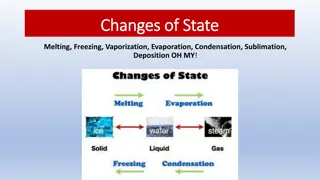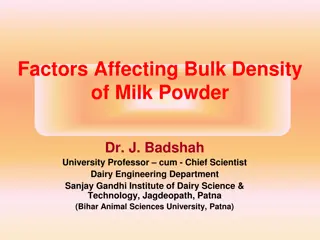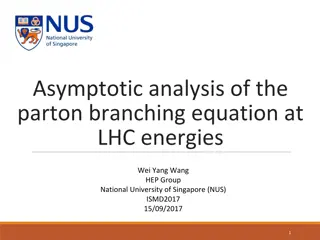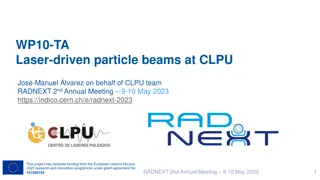Understanding Particle-on-a-Ring Approximation in Chemistry
Delve into the fascinating world of the particle-on-a-ring approximation in chemistry, exploring concepts like quantum quantization of energy levels, De Broglie approach, Schrödinger equation, and its relevance to the electronic structure of molecules. Discover how confining particles to a ring leads to intriguing outcomes and applications in understanding the behavior of electrons in conjugated systems.
Download Presentation

Please find below an Image/Link to download the presentation.
The content on the website is provided AS IS for your information and personal use only. It may not be sold, licensed, or shared on other websites without obtaining consent from the author. Download presentation by click this link. If you encounter any issues during the download, it is possible that the publisher has removed the file from their server.
E N D
Presentation Transcript
Chemistry 2 Lecture 3 Particle on a ring approximation
Learning outcomes from Lecture 2 Be able to explain why confining a particle to a box leads to quantization of its energy levels Be able to explain why the lowest energy of the particle in a box is not zero Be able to apply the particle in a box approximation as a model for the electronic structure of a conjugated molecule (given equation for En). Assumed knowledge for today Be able to predict the number of electrons and the presence of conjugation in a ring containing carbon and/or heteroatoms such as nitrogen and oxygen.
The de Broglie Approach The wavelength of the wave associated with a particle is related to its momentum: p = mv = h / For a particle with only kinetic energy: E = mv2= p2 / 2m = h2 / 2m 2
Particle-on-a-ring Particle can be anywhere on ring Ground state is motionless
Particle-on-a-ring Ground state is motionless In higher levels, we must fit an integer number of waves around the ring 1 wave = 2 r 2 waves = 2 r/2 3 waves = 2 r/3
The Schrdinger equation The total energy is extracted by the Hamiltonian operator. These are the observable energy levels of a quantum particle Energy eigenfunction Hamiltonian operator Energy eigenvalue
The Schrdinger equation The Hamiltonian has parts corresponding to Kinetic Energy and Potential Energy. In terms of the angle : 2 2 2 ) H = = + + ( V 2 mr 2 Potential Energy Hamiltonian operator Kinetic Energy
The particle on a ring The ring is a cyclic 1d potential E must fit an integer number of wavelengths 0 2 0
The particle on a ring -system of benzene is like a bunch of electrons on a ring
The particle on a ring On the ring, V = 0. Off the ring V= . ( ( ) ) = = j sin 2 2 ( ( ) ) H = = j sin 2 2 mr 2 2 2 j ( ( ) ) = = j = = j sin j = 1, 2, 3 . 2 mr 2
The particle on a ring On the ring, V = 0. Off the ring V= . ( ( ) ) = = j cos 2 2 ( ( ) ) H = = j cos 2 2 mr 2 2 2 j ( ( ) ) = = j = = j cos j = 0, 1, 2, 3 . 2 mr 2
Particle-on-a-ring Ground state is motionless = constant
The particle on a ring The ring is a cyclic 1d potential E must fit an integer number of wavelengths 0 2 0
The particle on a ring 2 2 2 2 2 2 j j = = j = 0, 1, 2, 3 . j 2 2 2 mr mL length of circumference j = 3 radius of ring j = 2 j = 1 j = 0
The particle on a ring j = 3 All singly degenerate Doubly degenerate above j=0 n = 4 j = 2 n = 3 j = 1 n = 2 n = 1 j = 0 ring box
Application: benzene Question: how many -electrons in benzene? Answer: Looking at the structure, there are 6 carbon atoms which each contribute one electron each. Therefore, there are 6 electrons.
benzene Question: what is the length over which the - electrons are delocalized, if the average bond length is 1.40 ? Answer: There are six bonds, which equates to 6 1.40 = 8.40
benzene Question: if the energy levels of the electrons are given by n = 2 2j2 2/mL2, what is the energy of the HOMO in eV? j = 3 Answer: since there are 6 -electrons, and therefore the HOMO must have j=1. We know that L = 6 1.40 = 8.4 0 . From these numbers, we get j = 3.41 10-19j2 in Joules. The energy of the HOMO is thus 1 = 3.41 10-19J = 2.13 eV. j = 2 j = 1 j = 0
benzene Question: what is the energy of the LUMO, and thus the HOMO-LUMO transition? j = 3 Answer: j = 3.41 10-19 j2 in Joules. The energy of the LUMO is thus 2 = 1.365 10-18J = 8.52 eV. The energy of the HOMO-LUMO transition is thus 6.39 eV. j = 2 j = 1 j = 0
benzene Question: how does the calculated value of the HOMO-LUMO transition compare to experiment? Answer: The calculated energy of the HOMO-LUMO transition is 6.39 eV. This corresponds to photons of wavelength j = 3 = hc/(6.39 1.602 10-19) ~ 194 nm, which is not so far from the experimental value (around 200 nm). Hiraya and Shobatake, J. Chem. Phys. 94, 7700 (1991) j = 2 j = 1 j = 0
Learning Outcomes Be able to explain why confining a particle on a ring leads to quantization of its energy levels Be able to explain why the lowest energy of the particle on a ring is zero Be able to apply the particle on a ring approximation as a model for the electronic structure of a cyclic conjugated molecule (given equation for En).
Next lecture Quantitative molecular orbital theory for beginners Week 10 tutorials Schr dinger equation and molecular orbitals for diatomic molecules
Practice Questions 1. The particle on a ring has an infinite number of energy levels (since j = 0, 1,2, 3, 4, 5 ) whereas for a ring CnHn has only n p-orbitals and so n energy levels. C6H6, for example, only has levels with j = 3 (one level), j = 1 (two levels), j = 2 (two levels) and j = 3 (one level) (a) Using the analogy between the particle on a ring waves and the - orbitals on slide 17, draw the four molecular orbitals for C4H4 and the six molecular orbitals for C6H6 (b) Using qualitative arguments (based on the number of nodes and/or the number of in-phase or out-of-phase interactions between neighbours) construct energy level diagrams and label the orbitals as bonding, non-bonding or antibonding (c) Based on your answer to (b), why is C6H6 aromatic and C4H4 antiaromatic?




